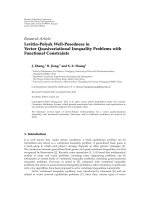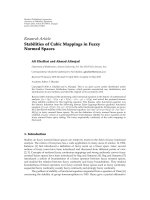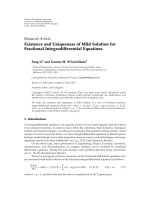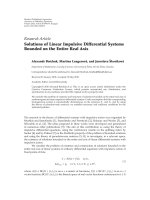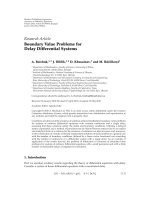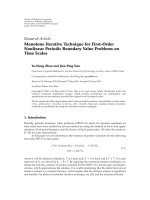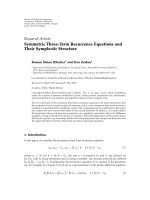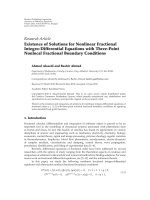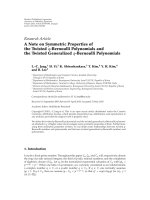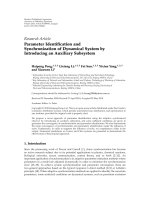Báo cáo sinh học: " Research Article Levitin-Polyak Well-Posedness in Vector Quasivariational Inequality Problems with Functional Constraints" pptx
Bạn đang xem bản rút gọn của tài liệu. Xem và tải ngay bản đầy đủ của tài liệu tại đây (534.84 KB, 16 trang )
Hindawi Publishing Corporation
Fixed Point Theory and Applications
Volume 2010, Article ID 984074, 16 pages
doi:10.1155/2010/984074
Research Article
Levitin-Polyak Well-Posedness in
Vector Quasivariational Inequality Problems with
Functional Constraints
J. Zhang,
1
B. Jiang,
2
and X. X. Huang
3
1
School of Mathematics and Physics, Chongqing University of Posts and Telecommunications,
Chongqing 400065, China
2
Department of Systems Engineering and Engineering Management,
The Chinese University of Hong Kong, Shatin, Hong Kong
3
School of Economics and Business Administration, Chongqing University, Chongqing 400030, China
Correspondence should be addressed to X. X. Huang,
Received 17 March 2010; Accepted 6 July 2010
Academic Editor: Lai Jiu Lin
Copyright q 2010 J. Zhang et al. This is an open access article distributed under the Creative
Commons Attribution License, which permits unrestricted use, distribution, and reproduction in
any medium, provided the original work is properly cited.
We introduce several types of Levtin-Polyak well-posedness for a vector quasivariational
inequality with functional constraints. Necessary and/or sufficient conditions are derived for
them.
1. Introduction
It is well known that, under certain conditions, a N ash equilibrium problem can be
formulated and solved as a variational inequality problem. A generalized Nash game is
a Nash game in which each player’s strategy depends on other players’ strategies 1.
The connection between generalized Nash games and quasivariational inequalities was first
recognized by Bensoussan 2. Recently, some researchers 1, 3, 4 found that mathematical
models of many real world problems, including some engineering problems, can be
formulated as certain kinds of variational inequality problems, including quasivariational
inequality problems. However, as noted in 5, compared with variational inequality
problems, the study on q uasivariational inequality problems is still in its infancy, in particular
only a few algorithms have been proposed to solve variational inequalities numerically.
Vector variational inequality problems were introduced by Giannessi 6 and are
related to vector network equilibrium problems 7. Since then, various types of vector
2 Fixed Point Theory and Applications
variational inequalities were introduced and studied see, e.g., 8, 9 and the references
therein.
In this paper, we will consider vector quasivariational inequality problems with
functional constraints, which are described below.
Let X, · be a normed space and Z, d
1
a metric space. Let X
1
⊆ X, K ⊆ Z
be nonempty and closed sets. Let Y be a locally convex space and C ⊆ Y be a nontrivial
closed and convex cone with nonempty interior int C. Define the following order in Y,for
any y
1
,y
2
∈ Y ,
y
1
≤ y
2
⇐⇒ y
2
− y
1
∈ C. 1.1
Let LX, Y be the space of all the linear continuous operators from X to Y .LetF : X
1
→
LX, Y and g : X
1
→ Z be two functions. We denote by Fx,z the function value Fxz,
where z ∈ X
1
.LetS : X
1
→ 2
X
1
be a strict set-valued map i.e., Sx
/
∅, for all x ∈ X
1
.
Let
X
0
x ∈ X
1
: g
x
∈ K
. 1.2
The vector quasivariational inequality problem with functional and abstract set
constraints considered in this paper is:
Find
x ∈ X
0
such that x ∈ S
x
satisfying
F
x
,x− x
/
∈−int C, ∀x ∈ S
x
.
VQVI
Denote by
X the solution set of VQVI.
Well-posedness for unconstrained and constrained optimization problems was first
studied by Tikhonov 10 and Levitin and Polyak 11. The issue being considered is that for
each approximating solution sequence, there exists a subsequence that converges to a solution
of the problem.
In Tikhonov’s well posedness, the approximating solution is always feasible. However,
it should be noted that many algorithms in optimization and variational inequalities, such as
penalty-type methods and augmented Lagrangian methods, terminate when the constraint is
approximately satisfied. These methods may generate sequences that may not be necessarily
feasible 12.
Up to now, various extensions of these well posednesses have been developed and
well studied see, e.g., 13–18. Studies on well posedness of optimization problems have
been extended to vector optimization problems see e.g., 19–24. The study of Levitin-
Polyak well posedness for scalar convex optimization problems with functional constraints
originates from 25. Recently, this research was extended to nonconvex optimization
problems with abstract and functional constraints 12 and nonconvex vector optimization
problems with both abstract and functional constraints 26. Well-posedness of variational
inequality problems, mixed variational inequality problems, and equilibrium problems
without functional constraints was investigated in the literature see, e.g., 27–30. Well-
posedness in variational inequality problems with both abstract and functional constraints
was investigated in 31. Well-posedness of generalized quasivariational inequality and
Fixed Point Theory and Applications 3
mixed quasivariational-like inequalities has been studied in the literature 32–35.Thestudy
of well posedness for generalized vector variational inequality, vector quasiequilibria and
vector equilibrium problems can be found in 36–39 and the references therein.
In this paper, we will introduce and study several types of Levitin-Polyak LP in
short well posednesses and generalized LP well posednesses for vector quasivariational
inequalities with functional constraints. The paper is organized as follows. In Section 2, four
types of LP well posednesses and generalized LP well posednesses for vector quasivariational
inequality problems will be defined. In Section 3, we will derive various criteria and
characterizations for the various generalized LP well posednesses of constrained vector
quasivariational inequalities.
2. Definitions and Preliminaries
Let Z
1
, Z
2
be two normed spaces. A set-valued map G from Z
1
to 2
Z
2
is
i closed, on Z
3
⊆ Z
1
, if for any sequence {x
n
}⊆Z
3
with x
n
→ x ∈ Z
3
and y
n
∈ Gx
n
with y
n
→ y, one has y ∈ Gx;
ii lower semicontinuous (l.s.c. in short) at x ∈ Z
1
,if{x
n
}⊆Z
1
, x
n
→ x,andy ∈ Gx
imply that there exists a sequence {y
n
}⊆Z
2
satisfying y
n
→ y such that y
n
∈ Gx
n
for n sufficiently large. If G is l.s.c. at each point of Z
1
, we say that G is l.s.c on Z
1
.
Let P, d
2
be a metric space, P
1
⊆ P,andp ∈ P. In the sequel, we denote by d
P
1
p
inf{dp, p
: p
∈ P
1
} the distance function from point p to set P
1
. For a topological vector
space V , we denote by V
∗
its dual space. For any cone Φ ⊆ V , we will denote the positive
polar cone of Φ by
Φ
∗
φ ∈ V
∗
: φ
v
≥ 0, ∀v ∈ Φ
. 2.1
Let e ∈ int C be fixed. Denote
C
∗0
{
λ ∈ C
∗
: λ
e
1
}
.
2.2
Throughout this paper, we always assume that the feasible set X
0
is nonempty and the
function g is continuous on X
1
.
Definition 2.1. i A sequence {x
n
}⊆X
1
is called a type I Levtin-Polyak LP in short
approximating solution sequence if there exists {
n
}⊆R
1
with
n
→ 0 such that
d
X
0
x
n
≤
n
, 2.3
x
n
∈ S
x
n
, 2.4
F
x
n
,x− x
n
n
e
/
∈−int C, ∀x ∈ S
x
n
. 2.5
ii {x
n
}⊆X
1
is called a type II LP approximating solution sequence if there exist
{
n
}⊆R
1
with
n
→ 0and{y
n
}⊆X
1
with y
n
∈ Sx
n
such that 2.3–2.5 hold and
F
x
n
,y
n
− x
n
−
n
e ∈−C. 2.6
4 Fixed Point Theory and Applications
iii {x
n
}⊆X
1
is called a generalized type I LP approximating solution sequence if
there exists {
n
}⊆R
1
with
n
→ 0 such that
d
K
g
x
n
≤
n
, 2.7
and 2.4, 2.5 hold.
iv {x
n
}⊆X
1
is called a generalized type II LP approximating solution sequence if
there exist {
n
}⊆R
1
with
n
→ 0and{y
n
}⊆X
1
with y
n
∈ Sx
n
such that 2.4–2.7 hold.
Definition 2.2. VQVI is said to be type I resp., type II, generalized type I, generalized type
II LP well posed if the solution set
X of VQVI is nonempty, and for any type I resp., type
II, generalized type I, generalized type II LP approximating solution sequence {x
n
}, there
exist a subsequence {x
n
j
} of {x
n
} and x ∈ X such that x
n
j
→ x.
Remark 2.3. i It is easily seen that if Y R
1
, C R
1
, then type I resp., type II, generalized
type I, generalized type II LP well posedness of VQVI reduces to type I resp., type II,
generalized type I, generalized type II LP well posedness of QVI defined in 34.
ii It is clear that any generalized type II LP approximating solution sequence is a
generalized type I LP approximating solution sequence. Thus, generalized type I LP well
posedness implies generalized type II LP well posedness.
iiiEach type of LP well posedness of VQVI implies that its solution set
X is
compact.
To see that the various LP well posednesses of VQVI are adaptations of the
corresponding LP well posednesses in minimizing problems by using the Auslender gap
function, we consider the following general constrained optimization problem:
min f
x
s.t.x∈ X
1
g
x
∈ K,
P
where X
1
⊆ X
1
is nonempty and f : X
1
→ R
1
∪{∞} is proper. The feasible set of P is X
0
,
where X
0
{x ∈ X
1
: gx ∈ K}. The optimal set and optimal value of P are denoted by
X
and v, respectively. Note that if Domf ∩ X
0
/
∅, where
Dom
f
x ∈ X
1
: f
x
< ∞
, 2.8
then
v<∞. In this paper, we always assume that v>−∞. We note that LP well posedness
for the special case, where f is finite valued and l.s.c., X
1
is closed, has been studied in 12.
Definition 2.4. i A sequence {x
n
}⊆X
1
is called a type I LP minimizing sequence for P if
lim sup
n → ∞
f
x
n
≤
v,
2.9
d
X
0
x
n
−→ 0.
2.10
Fixed Point Theory and Applications 5
ii {x
n
}⊆X
1
is called a type II LP minimizing sequence for P if
lim
n → ∞
f
x
n
v
2.11
and 2.10 hold.
iii {x
n
}⊆X
1
is called a generalized type I LP minimizing sequence for P if
d
K
g
x
n
−→ 0. 2.12
and 2.9 hold.
iv {x
n
}⊆X
1
is called a generalized type II LP minimizing sequence for P if 2.11
and 2.12 hold.
Definition 2.5. P is said to be type I resp., type II, generalized type I, generalized type
II LP well posed if the solution set
X
of P is nonempty, and for any type I resp.,
type II, generalized type I, generalized type II LP minimizing sequence {x
n
}, there exist
a subsequence {x
n
j
} of {x
n
} and x ∈ X
such that x
n
j
→ x.
The Auslender gap function for VQVI is
f
x
sup
x
∈S
x
inf
λ∈C
∗0
λ
F
x
,x− x
λ
e
, ∀x ∈ X
1
.
2.13
From Lemma 1.1in40,weknowthatC
∗0
is weak
∗
compact. This fact combined with that
λe1 when λ ∈ C
∗0
implies that
f
x
sup
x
∈S
x
min
λ∈C
∗0
λ
F
x
,x− x
, ∀x ∈ X
1
.
2.14
Recall the following nonlinear scalarization function see, e.g., 9:
ξ : Y −→ R
1
: ξ
y
min
t ∈ R
1
: y − te ∈−C
. 2.15
It is known that ξ is a continuous, strictly monotone i.e., for any y
1
, y
2
∈ Y , y
1
− y
2
∈
C implies that ξy
1
≥ ξy
2
and y
1
− y
2
∈ int C implies that ξy
1
>ξy
2
, subadditive, and
convex function. Moreover, for any t ∈ R
1
, it holds that ξtet. Furthermore, following the
proof of 9,Proposition1.44, we can prove that
ξ
y
sup
λ∈C
∗0
λ
y
λ
e
max
λ ∈C
∗0
λ
y
, ∀y ∈ Y.
2.16
Let X
2
⊆ X be defined by
X
2
{
x ∈ X
1
| x ∈ S
x
}
. 2.17
6 Fixed Point Theory and Applications
First we have the following lemma.
Lemma 2.6. Let f be defined by 2.14,then
i fx ≥ 0, for all x ∈ X
2
∩ X
0
,
ii fx0 and x ∈ X
2
∩ X
0
if and only if x ∈ X.
Proof. i Let x ∈ X
2
∩ X
0
, then x ∈ Sx.Weletx
in 2.14 be equal to x, then fx ≥ 0.
ii Assume that fx0. Suppose to the contrary that x
/
∈
X, then, there exists x
0
∈
Sx such that
F
x
,x
0
− x
∈−int C. 2.18
Thus,
λ
F
x
,x− x
0
> 0, ∀λ ∈ C
∗0
.
2.19
It follows that
min
λ∈C
∗0
λ
F
x
,x− x
0
> 0.
2.20
Hence, fx > 0, contradicting the assumption, so x ∈
X. Conversely, assume that x ∈ X,
then we have
x ∈ X
2
∩ X
0
,
F
x
,x
− x
/
∈−int C, ∀x
∈ S
x
. 2.21
As a result, for any x
∈ Sx, there exists λ ∈ C
∗0
such that
λF
x
,x− x
≤0. 2.22
It follows that fx ≤ 0. This fact combined with i implies that fx0.
In the rest of this paper, we set X
1
in P equal to X
2
. Note that if the set-valued map
S is closed on X
2
, then X
1
is closed. By Lemma 2.6, x ∈ X if and only if x minimizes fx
defined by 2.26 over X
0
∩ X
2
with fx0.
The following lemma establishes some relationship between LP approximating
solution sequence and LP minimizing sequence.
Lemma 2.7. Let the function f be defined by 2.14 as follows:
i {x
n
}⊆X
1
is a sequence such that there exists {
n
}⊆R
1
with
n
→ 0 satisfying 2.4-
2.5 if and only if {x
n
}⊆X
1
and 2.9 holds with v 0.
ii {x
n
}⊆X
1
is a sequence such that there exist {
n
}⊆R
1
with
n
→ 0 and {y
n
}⊆X
1
with
y
n
∈ Sx
n
satisfying 2.4–2.6 if and only if {x
n
}⊆X
1
and 2.11 holds with v 0.
Fixed Point Theory and Applications 7
Proof. i Let {x
n
}⊆X
1
be any sequence, if there exists {
n
}⊆R
1
with
n
→ 0 satisfying
2.4-2.5, then we can easily verify that
{
x
n
}
⊆ X
1
,f
x
n
≤
n
. 2.23
It follows that 2.9 holds with
v 0.
For the converse, let {x
n
}⊆X
1
and 2.9 hold. We can see that {x
n
}⊆X
1
and 2.4
hold. Furthermore, by 2.9, we have that there exists
{
n
}
⊆ R
1
with
n
−→ 0
2.24
such that
f
x
n
≤
n
. 2.25
That is,
sup
x
∈Sx
n
inf
λ∈C
∗0
λ
F
x
n
,x
n
− x
≤
n
.
2.26
Now, we will show that 2.5 holds, otherwise there exists x
0
∈ Sx
n
such that
F
x
n
,x
0
− x
n
n
e ∈−int C. 2.27
As a result, for any λ ∈ C
∗0
, λFx
n
,x
n
− x
0
>
n
. Since C
∗0
is a weak
∗
compact set, we have
inf
λ∈C
∗0
λ
F
x
n
,x
n
− x
0
>
n
,
2.28
which contradicts 2.26.
ii Let {x
n
}⊆X
1
be any sequence, we can check that
lim inf
n → ∞
f
x
n
≥ 0,
2.29
holds if and only if there exists {α
n
}⊆R
1
with α
n
→ 0and{y
n
}⊆X
1
with y
n
∈ Sx
n
such
that 2.6with
n
replaced by α
n
holds. From the proof of i, we know that
lim sup
n → ∞
f
x
n
≤ 0
2.30
and {x
n
}⊆X
1
hold if and only if {x
n
}⊆X
1
such that there exists {β
n
}⊆R
1
with β
n
→
0 satisfying 2.4-2.5with
n
replaced by β
n
. Finally, we set
n
max{α
n
,β
n
} and the
conclusion follows.
The next proposition establishes relationships between the various LP well posed-
nesses of VQVI and those of P with fx defined by 2.14.
8 Fixed Point Theory and Applications
Proposition 2.8. Assume that
X
/
∅,then
iVQVI is generalized type I (resp., generalized type II) LP well posed if and only if P is
generalized type I (resp., generalized type II) LP well posed with fx defined by 2.14.
ii If VQVI is type I (resp., type II) LP well posed, P is type I (resp., type II) LP well posed
with fx defined by 2.14.
Proof. By Lemma 2.6,if
X
/
∈∅, x is a solution of VQVI if and only if x is an optimal solution
of P with
v fx0andfx defined by 2.14.
i Similar to the proof of Lemma 2.7, it is also routine to check that a sequence {x
n
}
is a generalized type I resp., generalized type II LP approximating solution sequence if and
only if it is a generalized type I resp., generalized type II LP minimizing sequence of P.
So VQVI is generalized type I resp., generalized type II LP well posed if and only if P is
generalized type I resp., generalized type II LP well posed with fx defined by 2.26.
ii Since X
0
⊆ X
0
, d
X
0
x ≤ d
X
0
x for any x. This fact together with Lemma 2.7 implies
that a type I resp., type II LP minimizing sequence of P is a type I resp., type II LP
approximating solution sequence. So type I resp., type II LP well posedness of VQVI
implies type I resp., type II LP well posedness of P with fx defined by 2.26.
To end this section, we note that all the results in 12 for the well posedness hold for
P so long as X
1
is closed, f is l.s.c. on X
1
,andDomf ∩ X
0
/
∅.
3. Criteria and Characterizations for
Various LP Well-Posedness of VQVI
In this section, we give necessary and/or sufficient conditions for the various types of
generalized LP well posednesses defined in Section 2.
Consider the following statement:
X
/
∅ and for any type I
resp., type II, generalized type I, generalized type II
LP
approximating solution sequence
{
x
n
}
, we have d
X
x
n
−→ 0
.
3.1
The next proposition can be straightforwardly proved.
Proposition 3.1. If VQVI is type I (resp., type II, generalized type I, generalized type II) LP well
posed, then 3.1 holds. Conversely, if 3.1 holds and
X is compact, then VQVI is type I (resp., type
II, generalized type I, generalized type II) LP well posed.
Now, we consider a real-valued function c ct, s, r defined for t, s, r ≥ 0sufficiently
small such that
c
t, s, r
≥ 0, ∀t, s, r, c
0, 0, 0
0,
s
n
−→ 0,t
n
≥ 0,r
n
0,c
t
n
,s
n
,r
n
−→ 0 imply that t
n
−→ 0.
3.2
Fixed Point Theory and Applications 9
With the help of Lemma 2.7, analogously to 35, Theorems 3.1, and 3.2, we can prove
the following two theorems.
Theorem 3.2. If VQVI is type II LP well posed, the set-valued map S is closed valued, then there
exists a function c satisfying 3.2 such that
f
x
≥ c
d
X
x
,d
X
0
x
,d
Sx
x
∀x ∈ X
1
, 3.3
where fx is defined by 2.14. Conversely, suppose t hat
X is nonempty and compact, and 3.3 holds
for some c satisfying 3.2,thenVQVI is type II LP well posed.
Theorem 3.3. If VQVI is type II LP well posed in the generalized sense, the set-valued mapping S
is closed, t hen there exists a function c satisfying 3.2 such that
f
x
≥ c
d
X
x
,d
K
g
x
,d
Sx
x
∀x ∈ X
1
, 3.4
where fx is defined by 2.14. Conversely, suppose t hat
X is nonempty and compact, and 3.4 holds
for some c satisfying 3.2,thenVQVI is generalized type II LP well posed.
Next we give Furi-Vignoli type characterizations 41 for the generalized type I LP
well posednesses of VQVI.
Let X, · be a Banach space. Recall that the Kuratowski measure of noncompactness
for a subset H of X is defined as
μ
H
inf
>0:H ⊆
n
i1
H
i
, diam
H
i
<, i 1, ,n
,
3.5
where diamH
i
is the diameter of H
i
defined by
diam
H
i
sup
{
x
1
− x
2
: x
1
,x
2
∈ H
i
}
. 3.6
For any ≥ 0, define
Ψ
1
x ∈ X
1
: f
x
≤ v , d
X
0
x
≤
,
Ψ
2
x ∈ X
1
: f
x
≤ v , d
K
g
x
≤
.
3.7
Lemma 3.4. Let fx be defined by 2.14 and
v 0.Let
Ω
1
x ∈ X
1
: x ∈ S
x
,d
X
0
x
≤ ,
F
x
,x
− x
e
/
∈−int C, ∀x
∈ S
x
, 3.8
Ω
2
x ∈ X
1
: x ∈ S
x
,d
K
g
x
≤ ,
F
x
,x
− x
e
/
∈−int C, ∀x
∈ S
x
, 3.9
then one has Ψ
1
⊂ Ω
1
and Ψ
2
Ω
2
.
10 Fixed Point Theory and Applications
Proof. First, we prove the former result. For any x ∈ X
1
satisfying
f
x
≤ , d
X
0
x
≤ ,
3.10
we have x ∈ X
1
and x ∈ Sx. We will show that Fx,x
− x e
/
∈−int C, for all x
∈
Sx. Otherwise, there exists x
∈ Sx such that Fx,x
− x e ∈−intC. By the weak
∗
compactness of C
∗0
, we have inf
λ∈C
∗0
λFx,x−x
>, which leads to fx >and gives rise
to a contradiction. Furthermore, we observe that X
0
⊆ X
0
. This fact combined with d
X
0
x ≤
implies that d
X
0
x ≤ .
Now, we prove the equivalence between Ψ
2
and Ω
2
. Firstly, we can establish the
same inclusion for Ψ
2
and Ω
2
analogously to the proof stated above. Then if x ∈ X
1
satisfies x ∈ Sx,d
K
x ≤ and
F
x
,x
− x
e
/
∈−int C, ∀x
∈ S
x
. 3.11
It is routine to check that x ∈ X
1
.From3.11, we know that for each x
∈ Sx, there exists
λ ∈ C
∗0
such that λFx,x− x
≤. As a result, we can see that fx ≤ . Thus, we prove the
conclusion.
The next lemma can be proved analogously to 25, Theorem 5.5.
Lemma 3.5. Let X, · be a Banach space. Suppose that f is l.s.c. on X
1
and bounded below on X
0
.
Assume that the optimal solution set of P is nonempty and compact, then, P is (generalized) type
I LP well posed if and only if
lim
→ 0
μ
Ψ
2
0.
lim
→ 0
μ
Ψ
1
0. 3.12
To continue our study, we make some assumptions below.
Assumption 1. i X is a Banach space.
ii The set-valued map S is closed, and lower semicontinuous on X
1
.
iii The map F is continuous on X
1
.
We have the following lemma concerning the l.s.c. of f defined by 2.14.
Lemma 3.6. Let function f be defined by 2.14 and Assumption 1 hold, then f is l.s.c. function from
X
1
to R
1
∪{∞}. Further assume that the solution set X of VQVI is nonempty, then Domf
/
∅.
Proof. First we show that fx > −∞, for all x ∈ X
1
. Suppose to the contrary that there exists
x
0
∈ X
1
such that fx
0
−∞, then,
inf
λ∈C
∗0
λ
F
x
0
,x
0
− x
−∞, ∀x ∈ S
x
0
.
3.13
That is,
sup
λ∈C
∗0
λ
F
x
0
,x
0
− x
∞, ∀x ∈ S
x
0
.
3.14
Fixed Point Theory and Applications 11
Namely,
ξ
F
x
0
,x
0
− x
∞, ∀x ∈ S
x
0
, 3.15
which is impossible since ξ is a finite function on Y. Second, we show that f is l.s.c. on X
1
.
Note that the function
h
x, y
min
λ∈C
∗0
λ
F
x
,x− y
−ξ
F
x
,y− x
3.16
is continuous on X
1
× X
2
by the continuity of F on X
1
and the continuity of ξ.Wealsonote
that fxsup
y∈Sx
hx, y.Lett ∈ R
1
. Suppose that the sequence {x
n
}⊆X
1
satisfies
f
x
n
≤ t 3.17
and x
n
→ x
∗
∈ X
1
. For any y ∈ Sx
∗
, by the lower semicontinuity of S and continuity of h,
we have a sequence {y
n
} with y
n
∈ Sx
n
converging to y such that
h
x
∗
,y
lim
n → ∞
h
x
n
,y
n
≤ lim inf
n → ∞
f
x
n
≤ t.
3.18
It follows that fx
∗
sup
y∈Sx
hx
∗
,y ≤ t. Hence, f is l.s.c. on X
1
. Furthermore, if X
/
∅,by
Lemma 2.6,weseethatDomf
/
∅.
Theorem 3.7. Let Assumption 1 hold and let the solution set X of (QVVI) be nonempty and compact,
then, VQVI is generalized type I LP well posed if and only if
lim
→ 0
μ
Ω
2
0.
3.19
Proof. Note that the function fx defined by 2.14 is nonnegative on X
0
. By the lower
semicontinuity of S and Lemma 3.6, f is l.s.c. on X
1
X
1
∩ X
2
. Moreover, X
1
is closed, since
S is closed on X
1
∩ X
2
.ByProposition 2.8, Lemmas 3.4 and 3.5, the conclusion follows.
Although the type I type II LP well posedness of VQVI is not equivalent to the type
I type II LP well posedness of P, we can still establish the same characterization for type I
type II LP well posedness of VQVI as Theorem 3.7. We need the next lemma.
Lemma 3.8. Let Assumption 1 hold, then Ω
1
defined by 3.8 is closed.
Proof. Let x
n
∈ Ω
1
and x
n
→ x
0
. We show that x
0
∈ Ω
1
. It is obvious that d
X
0
x
0
≤ .
Since x
n
∈ Sx
n
and x
n
→ x
0
, by the closedness of S, we have x
0
∈ Sx
0
. Moreover, since
z
n
,x
− x
n
e
/
∈−int C, ∀x
∈ S
x
n
3.20
12 Fixed Point Theory and Applications
hold and S is l.s.c., for any y ∈ Sx
0
, we can find that y
n
∈ Sx
n
with {y
n
}→y such that
F
x
0
,y− x
0
lim
n →∞
F
x
n
,y
n
− x
n
e
/
∈−int C.
3.21
Hence, Ω
1
is closed.
Theorem 3.9. Let Assumption 1 hold and let Ω
1
be defined by 2.14. Assume that the solution
set
X of (QVVI) is nonempty and compact, then VQVI is type I LP well posed if and only if
lim
→ 0
μ
Ω
1
0.
3.22
Proof. The proof is similar to that of Theorem 3.4in35 and thus omitted.
Example 3.10. i Let X Y R
2
, C R
2
, e 1, 1
T
, X
1
R
2
,andX
0
R
2
. F maps R
2
into
an identical mapping, that is to say Fx,y y
1
,y
2
T
, for any x, y ∈ R
2
. The set valued
mapping S is defined as follows, given y ∈ Sx for some x, y ∈ R
2
, then
y
i
⎧
⎨
⎩
x
i
, 1
, if x
i
≤ 1,
2x
i
− 1, 3x
i
− 2
, if x
i
> 1,
3.23
with i ∈{1, 2}, of course S is closed and l.s.c. Now, we can show that, when 0 ≤ ≤ 1,
Ω
1
⊆{x |− ≤ x
1
≤ 1, − ≤ x
2
≤ 1}, which is bounded. Thus, μΩ 0, by applying
Theorem 3.9, we know that VQVI is type I LP well posed.
i Suppose that G is a set-valued mapping from R
2
to 2
R
2
, for fixed x ∈ R
2
, y ∈ Gx
implies that
y
i
⎧
⎨
⎩
x
i
, 1
, if x
i
≤ 1,
1, 2x
i
− 1
, if x
i
> 1,
3.24
with i ∈{1, 2}, obviously G is still closed and l.s.c. If we replace S by G in i, then Ω
1
⊇{x |
− ≤ x
1
≤ 1, x
2
≥ 0} with 0 ≤ ≤ 1, which is unbounded. Therefore, lim
→ 0
μΩ
1
/
0and
the VQVI is not LP well posed in sense of type I. Actually, the solution set of this problem
is {x | 0 ≤ x
1
≤ 1,x
2
≥ 0}∪{x | 0 ≤ x
2
≤ 1,x
1
≥ 0} and thus unbounded.
Definition 3.11. i Let Z be a topological space, and let Z
1
⊆ Z be nonempty. Suppose that
h : Z → R
1
∪{∞} is an extended real-valued function. h is said to be level compact on Z
1
if, for any s ∈ R
1
, the subset {z ∈ Z
1
: hz ≤ s} is compact.
ii Let Z be a finite dimensional normed space, and let Z
1
⊆ Z be nonempty. A
function h : Z → R
1
∪{∞} is said to be level bounded on Z
1
if Z
1
is bounded or
lim
z∈Z
1
,
z
→ ∞
h
z
∞.
3.25
Fixed Point Theory and Applications 13
The f ollowing proposition presents some sufficient conditions for type I LP well
posedness of VQVI
Proposition 3.12. Let Assumption 1 hold. Further assume that one of the following conditions holds.
i There exists 0 <δ
1
<δ
0
such that X
1
δ
1
is compact, where
X
1
δ
1
{
x ∈ X
1
∩ X
2
: d
X
0
x
≤ δ
1
}
, 3.26
ii the function f defined by 2.14 is level compact on X
1
∩ X
2
,
iii X is finite dimensional and
lim
x∈X
1
∩X
2
,
x
→ ∞
max
f
x
,d
X
0
x
∞,
3.27
where f is defined by 2.14.
iv There exists 0 <δ
1
<δ
0
such that f is level-compact on X
1
δ
1
defined by 3.26. Then,
VQVI is type I LP well posed.
Proof. First, we show that each one of i, ii,andiii implies iv. Clearly, either of i and
ii implies iv. Now, we show that iii implies iv. We notice that the set X
1
∩ X
2
is closed
by the closedness of S. Then, we need only to show that for any t ∈ R
1
,theset
A
x ∈ X
1
δ
1
: f
x
≤ t
3.28
is bounded since X is a finite dimensional space and the function f defined by 2.14 is l.s.c.
on X
1
and, thus, A is closed. Suppose to the contrary that there exist t ∈ R
1
and {x
n
}⊆X
1
δ
1
such that x
n
→∞ and fx
n
≤ t.From{x
n
}⊆X
1
δ
1
, we have
d
X
0
x
n
≤ δ
1
. 3.29
Thus,
max
f
x
n
,d
X
0
x
n
≤ max
{
t, δ
1
}
, 3.30
which contradicts condition 3.27.
Now, we show that if iv holds, then VQVI is type I LP well posed. Let {x
n
} be
a type I LP approximating solution sequence of VQVI. Then, there exist {
n
}⊆R
1
with
n
→ 0andz
n
∈ Tx
n
such that
F
x
n
,x
− x
n
n
/
∈ int C, ∀x
∈ S
x
n
, 3.31
d
X
0
x
n
≤
n
, 3.32
x
n
∈ S
x
n
. 3.33
14 Fixed Point Theory and Applications
From 3.32 and 3.33, we can assume without loss of generality that {x
n
}⊆X
1
δ
1
.By
Lemma 2.7, we can assume without loss of generality that
{
x
n
}
⊆
x ∈ X
1
δ
1
: f
x
≤ 1
, 3.34
where f is defined by 2.14. By the level compactness of f on X
1
δ
1
, there exist a
subsequence of {x
n
j
} of {x
n
} and x ∈ X
1
δ
1
such that x
n
j
→ x. From t his fact and 3.32 ,we
have
x ∈ X
0
. Since S is closed and 3.33 holds, we also have x ∈ Sx.Thatis,
x ∈ X
0
∩ X
2
X
0
. 3.35
Furthermore, by Lemmas 2.7 and 3.6, we have
f
x
≤ lim inf
n → ∞
f
x
n
j
≤ lim sup
n → ∞
f
x
n
j
≤ 0.
3.36
We know that f
x ≥ 0byLemma 2.6,sofx0. This fact combined with 3.35 and
Lemma 2.6 implies that
x ∈ X.
Similarly, we can prove the next proposition.
Proposition 3.13. Let Assumption 1 hold. Further assume that one of the following conditions holds.
i There exists 0 <δ
1
<δ
0
such that X
2
δ
1
is compact, where
X
2
δ
1
x ∈ X
1
∩ X
2
: d
K
g
x
≤ δ
1
, 3.37
ii the function f defined by 2.14 is level compact on X
1
∩ X
2
,
iii X is finite dimensional and
lim
x∈X
1
∩X
2
,
x
→ ∞
max
f
x
,d
K
g
x
∞.
3.38
iv There exists 0 <δ
1
<δ
0
such that f is level compact on X
2
δ
1
defined by 3.37. Then,
VQVI is generalized type I LP well posed.
Remark 3.14. If X is finite dimensional, then the “level-compactness” condition in Proposi-
tions 3.12 and 3.13 can be replaced by the “level-boundedness” condition.
Now, we consider the case when Y is a normed space, K is a closed and convex cone
with nonempty interior int K and let e ∈ int K.
Let t ≥ 0 and denote
X
3
t
x ∈ X
1
∩ X
2
: g
x
∈ K − te
. 3.39
The next proposition follows immediately from Proposition 2.8i, Lemma 3.6,and
12,Proposition2.3iv.
Fixed Point Theory and Applications 15
Proposition 3.15. Let Y be a normed space, let K be a closed and convex cone with nonempty interior
int K and e ∈ int K. Let the set-valued map S be closed and l.s.c on X
1
. Assume that the solution set
X of VQVI is nonempty. Further assume that there exists t
1
> 0 such that the function fx defined
by 2.14 is level compact on X
3
t
1
,thenVQVI is generalized type I LP well posed.
Remark 3.16. If X is finite dimensional, then the level-compactness condition of f can be
replaced by the level boundedness of f.
Acknowledgment
This work is supported by the National Science Foundation of China.
References
1 F. Facchinei and J S. Pang, Finite-Dimensional Variational Inequalities and Complementarity Problems, vol.
1-2 of Springer Series in Operations Research, Springer, New York, NY, USA, 2003.
2 A. Bensoussan, “Points de nash dans le cas de fonctionnelles quadratiques et jeux diff
´
erentiels
lin
´
eaires
`
a N personnes,” SIAM Journal on Control and Optimization, vol. 12, pp. 460–499, 1974.
3 J S. Pang and M. Fukushima, “Quasi-variational inequalities, generalized Nash equilibria, and multi-
leader-follower games,” Computational Management Science, vol. 2, no. 1, pp. 21–56, 2005.
4 C. Baiocchi and A. Capelo, Variational and Quasivariational Inequalities, A Wiley-Interscience
Publication, John Wiley & Sons, New York, NY, U SA, 1984.
5 M. Fukushima, “A class of gap functions for quasi-variational inequality problems,” Journal of
Industrial and Management Optimization, vol. 3, no. 2, pp. 165–171, 2007.
6 F. Giannessi, “Theorems of alternative, quadratic programs and complementarity problems,” in
Variational Inequalities and Complementarity Problems, R. W. Cottle, F. Giannessi, and J. L. Lions, Eds.,
pp. 151–186, John Wiley & Sons, New York, NY, USA, 1980.
7 G. Y. Chen and N. D. Yen, “On the variational inequality model for network equilibrium,” Internal
Report 3.196 724, Department of Mathematics, University of Pisa, Pisa, Italy, 1993.
8 L. C. Ceng, G. Y. Chen, X. X. Huang, and J C. Yao, “Existence theorems for generalized vector
variational inequalities with pseudomonotonicity and their applications,” Taiwanese Journal of
Mathematics, vol. 12, no. 1, pp. 151–172, 2008.
9 G. Y. Chen, X. X. Huang, and X. Q. Yang, Vector Optimization, Set-Valued and Variational Analysis, vol.
541 of Lecture Notes in Economics and Mathematical Systems, Springe, Berlin, Germany, 2005.
10 A. N. Tikhonov, “On the stability of the functional optimization problem,” USSR Computational
Mathematics and Mathematical Physics, vol. 6, no. 4, pp. 28–33, 1966.
11 E. S. Levitin and B. T. Polyak, “Convergence of minimizing sequences in conditional extremum
problems,” Soviet Mathematics Doklady, vol. 7, pp. 764–767, 1966.
12 X. X. Huang and X. Q. Yang, “Generalized Levitin-Polyak well-posedness in constrained optimiza-
tion,” SIAM Journal on Optimization, vol. 17, no. 1, pp. 243–258, 2006.
13 G. Beer and R. Lucchetti, “The epi-distance topology: continuity and stability results with applications
to convex optimization problems,” Mathematics of Operations Research, vol. 17, no. 3, pp. 715–726, 1992.
14 A. L. Dontchev and T. Zolezzi, Well-Posed Optimization Problems, vol. 1543 of Lecture Notes in
Mathematics, Springer, Berlin, Germany, 1993.
15 J. P. Revalski, “Hadamard and strong well-posedness for convex programs,” SIAM Journal on
Optimization, vol. 7, no. 2, pp. 519–526, 1997.
16 R. Lucchetti and J. Revalski, Eds., Recent Developments in Well-Posed Variational Problems, vol. 331 of
Mathematics and its Applications, Kluwer Academic, Dodrecht, The Netherlands, 1995.
17 T. Zolezzi, “Well-posedness criteria in optimization with application to the calculus of variations,”
Nonlinear Analysis: Theory, Methods & Applications, vol. 25, no. 5, pp. 437–453, 1995.
18 T. Zolezzi, “Extended well-posedness of optimization problems,” Journal of Optimization Theory and
Applications, vol. 91, no. 1, pp. 257–266, 1996.
16 Fixed Point Theory and Applications
19 E. Bednarczuk, “Well-posedness of vector optimization problems,” in Recent Advances and Historical
Development of Vector Optimization Problems, J. Jahn and W. Krabs, Eds., vol. 294 of Lecture Notes in
Economics and Mathematical Systems, pp. 51–61, Springer, Berlin, Germany, 1987.
20 S. Deng, “Coercivity properties and well-posedness in vector optimization,” RAIRO Operations
Research, vol. 37, no. 3, pp. 195–208, 2003.
21 X. X. Huang, “Extended well-posedness properties of vector optimization problems,” Journal of
Optimization Theory and Applications, vol. 106, no. 1, pp. 165–182, 2000.
22 X. X. Huang, “Extended and strongly extended well-posedness of set-valued optimization problems,”
Mathematical Methods of Operations Research, vol. 53, no. 1, pp. 101–116, 2001.
23 P. Loridan, “Well-posedness in vector optimization,” in Recent Developments in Well-Posed Variational
Problems, vol. 331 of Mathematics and Its Applications, pp. 171–192, Kluwer Academic, Dodrecht, The
Netherlands, 1995.
24 R. Lucchetti, Well-Posedness Towards Vector Optimization, vol. 294 of Lecture Notes in Economics and
Mathematical System, Springer, New York, NY, USA, 1987.
25 A. S. Konsulova and J. P. Revalski, “Constrained convex optimization problems-well-posedness and
stability,” Numerical Functional Analysis and Optimization, vol. 15, no. 7-8, pp. 889–907, 1994.
26 X. X. Huang and X. Q. Yang, “Levitin-Polyak well-posedness of constrained vector optimization
problems,” Journal of Global Optimization, vol. 37, no. 2, pp. 287–304, 2007.
27 Y P. Fang, N J. Huang, and J C. Yao, “Well-posedness of mixed variational inequalities, inclusion
problems and fixed point problems,” Journal of Global Optimization, vol. 41, no. 1, pp. 117–133, 2008.
28 Y P. Fang, N J. Huang, and J C. Yao, “Well-posedness by perturbations of mixed variational
inequalities in Banach spaces,” European Journal of Operational Research, vol. 201, no. 3, pp. 682–692,
2010.
29 M. B. Lignola and J. Morgan, “α-well-posedness for Nash equilibria and for optimization problems
with Nash equilibrium constraints,” Journal of Global Optimization, vol. 36, no. 3, pp. 439–459, 2006.
30 M. B. Lignola and J. Morgan, “Generalized variational inequalities with pseudomonotone operators
under perturbations,” Journal of Optimization Theory and Applications, vol. 101, no. 1, pp. 213–220, 1999.
31 X. X. Huang, X. Q. Yang, and D. L. Zhu, “Levitin-Polyak well-posedness of variational inequality
problems with functional constraints,” Journal of Global Optimization, vol. 44, no. 2, pp. 159–174, 2009.
32 L. C. Ceng, N. Hadjisavvas, S. Schaible, and J. C. Yao, “Well-posedness for mixed quasivariational-like
inequalities,” Journal of Optimization Theory and Applications, vol. 139, no. 1, pp. 109–125, 2008.
33 M. B. Lignola, “Well-posedness and L-well-posedness for quasivariational inequalities,” Journal of
Optimization Theory and Applications, vol. 128, no. 1, pp. 119–138, 2006.
34 X. X. Huang, B. Jiang, and J. Zhang, “Levitin-Polyak well-posedness of quasivariational inequality
problems with functional constraints,” Natural Science Jourmal of Xiangtan University, vol. 30, pp. 1–11,
2008.
35 B. Jiang, J. Zhang, and X. X. Huang, “Levitin-Polyak well-posedness of generalized quasivariational
inequalities with functional constraints,” Nonlinear Analysis: Theory, Methods & Applications, vol. 70,
no. 4, pp. 1492–1503, 2009.
36 L. Q. Anh, P. Q. Khanh, D. T. M. Van, and J C. Yao, “Well-posedness for vector quasiequilibria,”
Taiwanese Journal of Mathematics, vol. 13, no. 2, pp. 713–737, 2009.
37 X. X. Huang and X. Q. Yang, “Levitin-Polyak well-posedness of vector variational inequality problems
with functional constraints,” Numerical Functional Analysis and Optimization, vol. 31, no. 4, pp. 440–459,
2010.
38 S. J. Li and M. H. Li, “Levitin-Polyak well-posedness of vector equilibrium problems,” Mathematical
Methods of Operations Research, vol. 69, no. 1, pp. 125–140, 2009.
39 G. Wang, X. X. Huang, J. Zhang, and G. Y. Chen, “Levitin-Polyak well-posedness for vector
equilibrium problems with functional constraints,” Acta Mathematica Scientia, vol. 30, no. 5, pp. 1400–
1412, 2010.
40 X. X. Huang, K. L. Teo, and X. Q. Yang, “Calmness and exact penalization in vector optimization with
cone constraints,” Computational Optimization and Applications, vol. 35, no. 1, pp. 47–67, 2006.
41 M. Furi and A. Vignoli, “About well-posed minimization problems for functionals in metric spaces,”
Journal of Optimization Theory and Applications, vol. 5, pp. 225–229, 1970.
